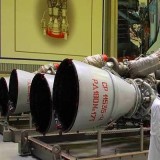Exclusive Report: Secrets Technology and Design of New China’s Shenyang J-50 Stealth Fighter Revealed

{loadposition bannertop}
{loadposition sidebarpub}
On December 26, 2024, a video showcased the new Shenyang J-50, China’s latest sixth-generation stealth fighter developed by the Shenyang Aircraft Corporation (SAC). The unveiling of this aircraft represents a significant leap in China’s military aviation capabilities, and an analysis by the Army Recognition editorial team reveals a glimpse into the secret technologies and combat capabilities integrated into this advanced platform. The J-50 integrates cutting-edge stealth technologies, advanced avionics, and a versatile armament system, making it a powerful tool for multi-domain operations. Follow Army Recognition on Google News at this link
The Shenyang J-50, China’s latest sixth-generation stealth fighter, captured during its flight debut on December 26, 2024, showcasing its cutting-edge design and advanced stealth capabilities. (Picture source: China Social Network)
The J-50 design focuses on survivability, with features such as twin Advanced Combat Engines (ACE), a swept-back wing design, and fully adjustable tail fins, collectively enhancing agility, speed, and operational range. These technologies suggest the J-50 is tailored for both air superiority and strike roles in contested environments, leveraging its stealth profile to reduce radar cross-section (RCS) and evade detection. This analysis underscores the J-50’s potential to challenge Western air dominance, positioning it as a critical asset in China’s evolving military strategy and a direct competitor to U.S. sixth-generation programs like the Next Generation Air Dominance (NGAD) initiative.
The Shenyang J-50 is built with an emphasis on performance and versatility. Featuring a twin-engine configuration powered by two ACEs, the J-50 delivers high thrust while ensuring operational redundancy, a critical feature for long-range or carrier-based missions. Its 22-meter length and 22-meter wingspan, paired with a swept-back wing design, provide aerodynamic efficiency and improved stealth characteristics. The fully adjustable tail fins enhance stability and maneuverability, particularly at high speeds or during sharp aerial maneuvers. Combined with its maximum envelope speed of 2.0 Mach (2,469 km/h) and a combat radius of 2,200 kilometers (km), these features establish the J-50 as a capable platform for both air superiority and deep-strike missions.
The J-50’s armament highlights its versatility in both offensive and defensive scenarios. It is equipped with four PL-15 (Pulse Line-15) long-range air-to-air missiles, four PL-17 (Pulse Line-17) advanced air-to-air missiles, and a YJ-12 (Ying Ji-12) supersonic anti-ship missile. The PL-15, one of the most advanced air-to-air missiles globally, features an active electronically scanned array (AESA) radar seeker and two-way data link, enabling it to engage highly maneuverable targets at ranges up to 300 kilometers. The PL-17, on the other hand, is optimized for engaging high-value targets like surveillance aircraft and bombers, using dual-pulse rocket motors and advanced radar evasion technology.
For maritime strike operations, the YJ-12 provides a formidable capability. This supersonic anti-ship missile, capable of reaching speeds of up to Mach 3, is designed to penetrate advanced naval defenses, including those of aircraft carriers. With a range of approximately 400 kilometers, the YJ-12 enhances the J-50’s ability to target enemy fleets while minimizing exposure to anti-aircraft defenses. The combination of these weapons makes the J-50 a flexible and lethal platform in a variety of combat scenarios, from establishing air dominance to engaging naval targets.
The unveiling of the J-50 invites inevitable comparisons to the U.S. Next Generation Air Dominance (NGAD) program. NGAD represents the U.S. Air Force’s sixth-generation fighter development initiative, aiming to replace the aging F-22 Raptor in the 2030s. Unlike the J-50, NGAD is envisioned as a system of systems, integrating a manned sixth-generation stealth fighter with autonomous Loyal Wingman drones, advanced AI capabilities, and adaptive engines. These engines are expected to reconfigure dynamically for optimal performance in speed, range, and fuel efficiency, a feature that may outmatch the J-50’s ACE engines.
Stealth is a core component of both the NGAD and the J-50, but their approaches differ. The J-50’s twin-engine configuration, swept-back wings, and fully adjustable tail fins enhance agility and maneuverability but slightly compromise stealth compared to the tailless, delta-wing design speculated for NGAD. Moreover, NGAD is expected to rely heavily on AI-driven mission management, which reduces pilot workload and enables faster decision-making in combat. By contrast, while the J-50 is rumored to feature advanced avionics and network-centric capabilities, its AI integration may not yet rival NGAD’s.
The U.S. F-35 Lightning II and China’s newly unveiled Shenyang J-50, highlighting their distinct design philosophies, with the F-35 emphasizing advanced systems integration and network-centric warfare, while the J-50 focuses on extended range, payload capacity, and stealth for contested environments. (Picture source U.S. DoD)
The Shenyang J-50 also invites comparisons to the U.S. F-35 Lightning II, a fifth-generation multirole stealth fighter renowned for its versatility and technological sophistication. While both aircraft share a focus on stealth and multirole capabilities, their design philosophies differ significantly. The J-50 is larger, with a longer wingspan and greater emphasis on long-range missions, evident in its 2,200-kilometer combat radius compared to the F-35’s approximate 1,200-kilometer combat radius. The J-50’s twin-engine configuration offers greater thrust and operational redundancy compared to the F-35’s single-engine design, potentially giving the J-50 an edge in survivability during engine failure scenarios. However, the F-35’s Pratt & Whitney F135 engine is widely regarded as one of the most advanced turbofan engines globally, offering superior fuel efficiency and thrust-to-weight ratio.
Technologically, the F-35 outpaces the J-50 in sensor fusion and network-centric warfare capabilities, allowing it to act as an airborne command center by sharing real-time data with other platforms. The F-35 also features the Electro-Optical Targeting System (EOTS) and advanced radar systems, such as the AN/APG-81 AESA radar, providing unmatched situational awareness and precision targeting. In contrast, while the J-50 is equipped with advanced avionics and a robust payload of long-range missiles like the PL-15 and PL-17, it may lack the level of integration and data-sharing capabilities that define the F-35. Additionally, the F-35 benefits from a mature production and logistics ecosystem, allowing for mass production and sustained operational support among allied nations, which China’s J-50 has yet to achieve. Despite these differences, the J-50’s superior range and heavy payload capacity make it better suited for extended operations in vast and contested regions like the Indo-Pacific, where aerial dominance and long-range strike capabilities are critical. However, the F-35’s advanced systems and proven track record in joint operations position it as a more technologically integrated and reliable platform in modern air combat.
The J-50 also invites comparisons to the recently revealed B-21 Raider, the U.S.’s next-generation stealth bomber. While the J-50 is primarily designed for air-to-air combat and tactical strikes, the B-21 is a strategic bomber specializing in deep-strike missions (DSM) over heavily contested airspace. The B-21’s intercontinental range far exceeds the J-50’s 2,200-kilometer combat radius, allowing it to deliver payloads anywhere in the world without relying on forward bases. However, the J-50’s focus on agility and speed makes it more suitable for dynamic combat roles, complementing China’s growing inventory of advanced unmanned combat aerial vehicles (UCAVs) like the CH-7 (Cai Hong-7).
The unveiling of the J-50 demonstrates China’s commitment to expanding its regional influence and challenging U.S. air dominance in the Indo-Pacific. As part of a broader strategy, the J-50 is designed to operate alongside China’s J-20 Mighty Dragon fifth-generation stealth fighter and advanced drones like the CH-7. This multi-layered approach to air combat allows China to field a combination of highly advanced systems that can overwhelm adversaries through sheer numbers, even if certain technological gaps remain.
However, the J-50 also highlights some ongoing challenges for China. While it has made significant advancements in stealth materials and avionics, areas like engine technology and AI integration still lag behind those of the U.S. platforms. The U.S., through programs like NGAD and the B-21 Raider, continues to maintain an edge in systems integration, adaptive propulsion, and the use of Loyal Wingman drones, which collectively enable a more cohesive and autonomous battlefield presence.
The Shenyang J-50 represents a significant milestone in China’s military aviation capabilities, offering a versatile and powerful platform for both air superiority and precision strike missions. While it may not yet rival the technological sophistication of U.S. programs like NGAD or the B-21 Raider, the J-50’s combination of stealth, speed, and armament makes it a formidable competitor. Its ability to be produced in large numbers further enhances its strategic value, potentially offsetting its technological disadvantages through sheer scale. As China and the U.S. continue to develop next-generation aircraft, the race for aerial superiority will remain a defining feature of 21st-century military competition, shaping the future of global security in contested regions like the Indo-Pacific.

{loadposition bannertop}
{loadposition sidebarpub}
On December 26, 2024, a video showcased the new Shenyang J-50, China’s latest sixth-generation stealth fighter developed by the Shenyang Aircraft Corporation (SAC). The unveiling of this aircraft represents a significant leap in China’s military aviation capabilities, and an analysis by the Army Recognition editorial team reveals a glimpse into the secret technologies and combat capabilities integrated into this advanced platform. The J-50 integrates cutting-edge stealth technologies, advanced avionics, and a versatile armament system, making it a powerful tool for multi-domain operations.
Follow Army Recognition on Google News at this link
The Shenyang J-50, China’s latest sixth-generation stealth fighter, captured during its flight debut on December 26, 2024, showcasing its cutting-edge design and advanced stealth capabilities. (Picture source: China Social Network)
The J-50 design focuses on survivability, with features such as twin Advanced Combat Engines (ACE), a swept-back wing design, and fully adjustable tail fins, collectively enhancing agility, speed, and operational range. These technologies suggest the J-50 is tailored for both air superiority and strike roles in contested environments, leveraging its stealth profile to reduce radar cross-section (RCS) and evade detection. This analysis underscores the J-50’s potential to challenge Western air dominance, positioning it as a critical asset in China’s evolving military strategy and a direct competitor to U.S. sixth-generation programs like the Next Generation Air Dominance (NGAD) initiative.
The Shenyang J-50 is built with an emphasis on performance and versatility. Featuring a twin-engine configuration powered by two ACEs, the J-50 delivers high thrust while ensuring operational redundancy, a critical feature for long-range or carrier-based missions. Its 22-meter length and 22-meter wingspan, paired with a swept-back wing design, provide aerodynamic efficiency and improved stealth characteristics. The fully adjustable tail fins enhance stability and maneuverability, particularly at high speeds or during sharp aerial maneuvers. Combined with its maximum envelope speed of 2.0 Mach (2,469 km/h) and a combat radius of 2,200 kilometers (km), these features establish the J-50 as a capable platform for both air superiority and deep-strike missions.
The J-50’s armament highlights its versatility in both offensive and defensive scenarios. It is equipped with four PL-15 (Pulse Line-15) long-range air-to-air missiles, four PL-17 (Pulse Line-17) advanced air-to-air missiles, and a YJ-12 (Ying Ji-12) supersonic anti-ship missile. The PL-15, one of the most advanced air-to-air missiles globally, features an active electronically scanned array (AESA) radar seeker and two-way data link, enabling it to engage highly maneuverable targets at ranges up to 300 kilometers. The PL-17, on the other hand, is optimized for engaging high-value targets like surveillance aircraft and bombers, using dual-pulse rocket motors and advanced radar evasion technology.
For maritime strike operations, the YJ-12 provides a formidable capability. This supersonic anti-ship missile, capable of reaching speeds of up to Mach 3, is designed to penetrate advanced naval defenses, including those of aircraft carriers. With a range of approximately 400 kilometers, the YJ-12 enhances the J-50’s ability to target enemy fleets while minimizing exposure to anti-aircraft defenses. The combination of these weapons makes the J-50 a flexible and lethal platform in a variety of combat scenarios, from establishing air dominance to engaging naval targets.
The unveiling of the J-50 invites inevitable comparisons to the U.S. Next Generation Air Dominance (NGAD) program. NGAD represents the U.S. Air Force’s sixth-generation fighter development initiative, aiming to replace the aging F-22 Raptor in the 2030s. Unlike the J-50, NGAD is envisioned as a system of systems, integrating a manned sixth-generation stealth fighter with autonomous Loyal Wingman drones, advanced AI capabilities, and adaptive engines. These engines are expected to reconfigure dynamically for optimal performance in speed, range, and fuel efficiency, a feature that may outmatch the J-50’s ACE engines.
Stealth is a core component of both the NGAD and the J-50, but their approaches differ. The J-50’s twin-engine configuration, swept-back wings, and fully adjustable tail fins enhance agility and maneuverability but slightly compromise stealth compared to the tailless, delta-wing design speculated for NGAD. Moreover, NGAD is expected to rely heavily on AI-driven mission management, which reduces pilot workload and enables faster decision-making in combat. By contrast, while the J-50 is rumored to feature advanced avionics and network-centric capabilities, its AI integration may not yet rival NGAD’s.

The U.S. F-35 Lightning II and China’s newly unveiled Shenyang J-50, highlighting their distinct design philosophies, with the F-35 emphasizing advanced systems integration and network-centric warfare, while the J-50 focuses on extended range, payload capacity, and stealth for contested environments. (Picture source U.S. DoD)
The Shenyang J-50 also invites comparisons to the U.S. F-35 Lightning II, a fifth-generation multirole stealth fighter renowned for its versatility and technological sophistication. While both aircraft share a focus on stealth and multirole capabilities, their design philosophies differ significantly. The J-50 is larger, with a longer wingspan and greater emphasis on long-range missions, evident in its 2,200-kilometer combat radius compared to the F-35’s approximate 1,200-kilometer combat radius. The J-50’s twin-engine configuration offers greater thrust and operational redundancy compared to the F-35’s single-engine design, potentially giving the J-50 an edge in survivability during engine failure scenarios. However, the F-35’s Pratt & Whitney F135 engine is widely regarded as one of the most advanced turbofan engines globally, offering superior fuel efficiency and thrust-to-weight ratio.
Technologically, the F-35 outpaces the J-50 in sensor fusion and network-centric warfare capabilities, allowing it to act as an airborne command center by sharing real-time data with other platforms. The F-35 also features the Electro-Optical Targeting System (EOTS) and advanced radar systems, such as the AN/APG-81 AESA radar, providing unmatched situational awareness and precision targeting. In contrast, while the J-50 is equipped with advanced avionics and a robust payload of long-range missiles like the PL-15 and PL-17, it may lack the level of integration and data-sharing capabilities that define the F-35.
Additionally, the F-35 benefits from a mature production and logistics ecosystem, allowing for mass production and sustained operational support among allied nations, which China’s J-50 has yet to achieve. Despite these differences, the J-50’s superior range and heavy payload capacity make it better suited for extended operations in vast and contested regions like the Indo-Pacific, where aerial dominance and long-range strike capabilities are critical. However, the F-35’s advanced systems and proven track record in joint operations position it as a more technologically integrated and reliable platform in modern air combat.
The J-50 also invites comparisons to the recently revealed B-21 Raider, the U.S.’s next-generation stealth bomber. While the J-50 is primarily designed for air-to-air combat and tactical strikes, the B-21 is a strategic bomber specializing in deep-strike missions (DSM) over heavily contested airspace. The B-21’s intercontinental range far exceeds the J-50’s 2,200-kilometer combat radius, allowing it to deliver payloads anywhere in the world without relying on forward bases. However, the J-50’s focus on agility and speed makes it more suitable for dynamic combat roles, complementing China’s growing inventory of advanced unmanned combat aerial vehicles (UCAVs) like the CH-7 (Cai Hong-7).
The unveiling of the J-50 demonstrates China’s commitment to expanding its regional influence and challenging U.S. air dominance in the Indo-Pacific. As part of a broader strategy, the J-50 is designed to operate alongside China’s J-20 Mighty Dragon fifth-generation stealth fighter and advanced drones like the CH-7. This multi-layered approach to air combat allows China to field a combination of highly advanced systems that can overwhelm adversaries through sheer numbers, even if certain technological gaps remain.
However, the J-50 also highlights some ongoing challenges for China. While it has made significant advancements in stealth materials and avionics, areas like engine technology and AI integration still lag behind those of the U.S. platforms. The U.S., through programs like NGAD and the B-21 Raider, continues to maintain an edge in systems integration, adaptive propulsion, and the use of Loyal Wingman drones, which collectively enable a more cohesive and autonomous battlefield presence.
The Shenyang J-50 represents a significant milestone in China’s military aviation capabilities, offering a versatile and powerful platform for both air superiority and precision strike missions. While it may not yet rival the technological sophistication of U.S. programs like NGAD or the B-21 Raider, the J-50’s combination of stealth, speed, and armament makes it a formidable competitor. Its ability to be produced in large numbers further enhances its strategic value, potentially offsetting its technological disadvantages through sheer scale. As China and the U.S. continue to develop next-generation aircraft, the race for aerial superiority will remain a defining feature of 21st-century military competition, shaping the future of global security in contested regions like the Indo-Pacific.




